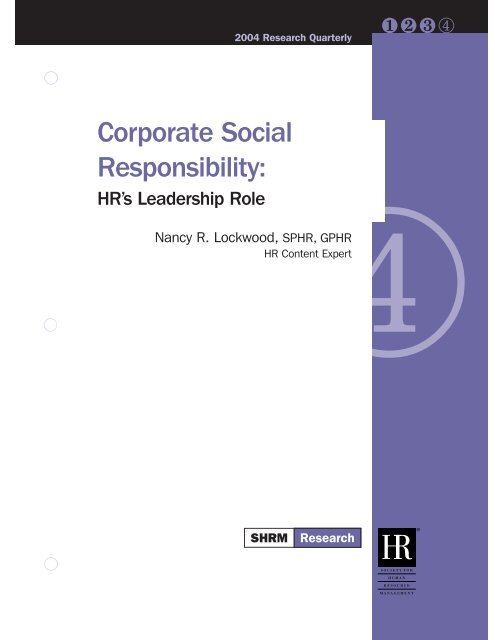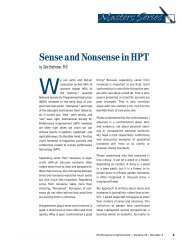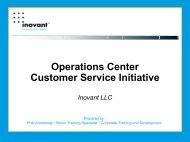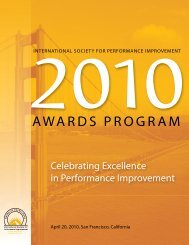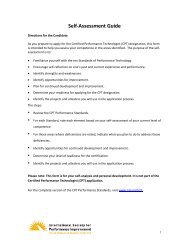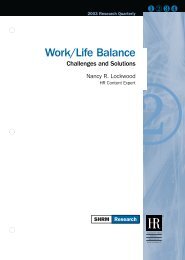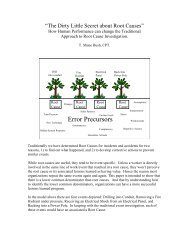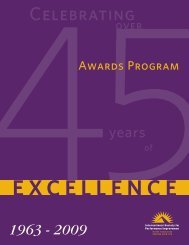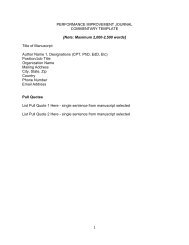Corporate Social Responsibility: HR's Leadership Role
Corporate Social Responsibility: HR's Leadership Role
Corporate Social Responsibility: HR's Leadership Role
You also want an ePaper? Increase the reach of your titles
YUMPU automatically turns print PDFs into web optimized ePapers that Google loves.
2004 Research Quarterly<br />
<br />
<strong>Corporate</strong> <strong>Social</strong><br />
<strong>Responsibility</strong>:<br />
HR’s <strong>Leadership</strong> <strong>Role</strong><br />
Nancy R. Lockwood, SPHR, GPHR<br />
HR Content Expert<br />
<br />
SHRM<br />
Research
2004 SHRM® Research Quarterly<br />
Abstract<br />
In a global economy, increasingly organizations have a responsibility to facilitate, demonstrate and promote<br />
corporate social responsibility (CSR). Long-term sustainability demands that organizations rethink<br />
their business goals and objectives from solely focusing on making a profit to corporate citizenship. Today,<br />
the impact of CSR is beginning to be seen in communities throughout the world—from human rights and<br />
labor practices to health care and the environment. At home and abroad, HR plays a critical role—that of<br />
leading and educating their firms regarding the importance of CSR while at the same time strategically<br />
implementing sound HR management practices that support the company’s business and CSR goals.<br />
“More and more companies are accepting corporate<br />
citizenship as a new strategic and managerial<br />
purpose requiring their attention. Once seen as a<br />
purely philanthropic activity—a source of general<br />
goodwill, with no bottom-line consequence—citizenship<br />
is moving from the margins of concern to the<br />
center at leading companies.” 1<br />
Introduction<br />
Today, there are many references to corporate social<br />
responsibility (CSR), sometimes referred to as corporate<br />
citizenship, in our workplaces, in the media, in<br />
the government, in our communities. While there is<br />
no agreed-upon definition, the World Business<br />
Council for Sustainable Development defines CSR as<br />
the business commitment and contribution to the<br />
quality of life of employees, their families and the<br />
local community and society overall to support sustainable<br />
economic development. 2 Simply put, the<br />
business case for CSR—establishing a positive company<br />
reputation and brand in the public eye through<br />
good work that yields a competitive edge while at the<br />
same time contributing to others—demands that<br />
organizations shift from solely focusing on making a<br />
profit to including financial, environmental and social<br />
responsibility in their core business strategies.Despite<br />
what the phrase corporate social responsibility suggests,<br />
the concept is not restricted to corporations<br />
but rather is intended for most types of organizations,<br />
such as associations, labor unions, organizations that<br />
serve the community for scientific, educational,<br />
artistic, public health or charitable purposes, and<br />
governmental agencies.<br />
In the late 1990s, CSR began to gain momentum<br />
as pressure from consumers, the media, activists<br />
1 Muirhead, S. A., Bennett, C. J., Berenbeim, R. E., Kao, A., & Vidal, D. J.<br />
(2002). <strong>Corporate</strong> citizenship in the new century: Accountability, transparency,<br />
and global stakeholder engagement. New York: The Conference Board, Inc.<br />
2 World Business Council for Sustainable Development. (2000, January).<br />
<strong>Corporate</strong> social responsibility: Making good business sense. Conches-<br />
Geneva, Switzerland: Author.<br />
3 The Center for <strong>Corporate</strong> Citizenship at Boston College and The U.S.<br />
Chamber of Commerce Center for <strong>Corporate</strong> Citizenship. (2004). The state<br />
of corporate citizenship in the U.S.: A view from inside 2003-2004.<br />
Chestnut Hill, MA: Author.<br />
4 Unilever. (2004). A perspective on corporate social responsibility in the<br />
21 st century. [Based on a speech by Niall FitzGerald, Unilever chairman,<br />
“CSR: Rebuilding Trust in Business,” pp. 2-3. Distinguished Speaker<br />
Series, London Business School.] London: Author.<br />
5 Zadek, S. (2001). The civil corporation: The new economy of corporate<br />
citizenship. London: Earthscan.<br />
and various public organizations demanded that<br />
companies contribute to society. In large part, the<br />
increasing focus on CSR has been fueled by a number<br />
of events in recent years, such as the highly<br />
publicized financial scandals of Enron and<br />
WorldCom, alleged sweatshop labor by retail clothing<br />
and sports shoe manufacturers and the alleged<br />
“under-the-table” deals that companies such as<br />
Halliburton have received. Now, reputation, brand,<br />
integrity and trust are increasingly considered important<br />
measures of corporate social responsibility.<br />
CSR in the Business Community<br />
Worldwide, companies and their HR leadership are<br />
coming to grips with what exactly CSR means in their<br />
organizations and how to strategically include CSR<br />
within business goals and objectives. There is growing<br />
evidence pointing to the validity of and the demand for<br />
CSR. For example, 82% of companies noted that good<br />
corporate citizenship helps the bottom line and 74%<br />
said the public has the right to expect good corporate<br />
citizenship. 3 However, as Niall FitzGerald, chairman of<br />
Unilever, explained in his presentation at the London<br />
Business School, “the reality of corporate social<br />
responsibility is there are no precedents to fall back<br />
on, and decisions must be based on judgment rather<br />
than tried and tested formulae.” 4<br />
As the concept of CSR becomes more widely<br />
accepted and integrated in business, it is helpful in<br />
this discussion to understand that the development<br />
of CSR in organizations is in transition (see<br />
Figure 1). There are basically three “generations”<br />
of CSR in varying stages of sophistication. The first<br />
generation has demonstrated that companies can<br />
contribute to society without risking commercial<br />
success. Today, the second generation is developing<br />
more fully as CSR gradually becomes an<br />
integral part of companies’ long-term business<br />
strategies. Finally, the third generation addresses<br />
significant societal issues, such as poverty and<br />
cleanup of the environment. 5 Evidence of the<br />
transition of CSR will be discussed throughout this<br />
article, with suggestions of how HR professionals<br />
can take on leadership roles that can contribute to<br />
CSR initiatives in their organizations. The article<br />
will also highlight some examples of the impact of<br />
CSR and how it may link to the bottom line.<br />
2<br />
<strong>Corporate</strong> <strong>Social</strong> <strong>Responsibility</strong>: HR’s <strong>Leadership</strong> <strong>Role</strong>
2004 SHRM® Research Quarterly<br />
<br />
Making the Business Case for CSR<br />
In recent years, intangible assets—company values,<br />
human and intellectual capital, reputation and<br />
brand equity—have become increasingly important<br />
to organizations. 6 Companies that exhibit good corporate<br />
citizenship are likely to gain a competitive<br />
edge. Below are just a few examples of today’s<br />
CSR success factors that are fast becoming the primary<br />
measures of an organization’s credibility.<br />
Reputation and Brand Enhancement<br />
Company reputation and brand are greatly influenced<br />
by public perception. For example, in the largest global<br />
survey of the public’s expectations, the Millennium<br />
Poll on <strong>Corporate</strong> <strong>Social</strong> <strong>Responsibility</strong> documented<br />
that over 25,000 individuals across 23 countries on<br />
six continents revealed they form their impressions<br />
of companies by focusing on corporate citizenship<br />
and two out of three people want companies to go<br />
beyond making money and contribute to broader<br />
society goals. 7 Increasingly, there are success stories<br />
that show companies are listening to the public. A<br />
recent example is that of Ecolab of St. Paul,<br />
Minnesota, that quickly developed new products to<br />
address unexpected hazards with an antimicrobial<br />
disinfectant product in response to foot and mouth<br />
disease in livestock and another new product to<br />
combat SARS at the Toronto airport. 8<br />
Today, companies are also seeking avenues of public<br />
acknowledgment of their employer brand. For example,<br />
Business Ethics <strong>Corporate</strong> <strong>Social</strong> <strong>Responsibility</strong><br />
6 Low, J., & Kalafut, P. C. (2002). Invisible advantage: How intangibles are<br />
driving business performance. Cambridge, MA: Perseus Publishing.<br />
7 Environics International, Ltd., The Prince of Wales Business Leaders and<br />
The Conference Board. (1999). Millennium poll on corporate social responsibility:<br />
Executive briefing. Toronto, Canada: Author.<br />
8 2004: 100 best corporate citizens. (2004, Spring). Business Ethics<br />
<strong>Corporate</strong> <strong>Social</strong> <strong>Responsibility</strong> Report, 18, 1, 8-12.<br />
9 Ibid.<br />
10 United Nations Industrial Development Organization. (2002). <strong>Corporate</strong><br />
social responsibility: Implications for small and medium enterprises in developing<br />
countries. Vienna: Author.<br />
Report publishes a list of the 100 best corporate citizens.<br />
Companies are ranked by social scores regarding<br />
environment, community and customer relations,<br />
employee relationships, and diversity. One of the<br />
2004 winners was Proctor & Gamble, which donated<br />
funds to help disadvantaged youth in Vietnam, combat<br />
childhood malnutrition in India and provide earthquake<br />
relief in Turkey. 9<br />
Another critical aspect of reputation and brand, as a<br />
CSR success factor, is the impact on a company’s<br />
sustainability—that is, the conditions or characteristics<br />
that support an organization to continue its business,<br />
including environmental, social and economic<br />
aspects of the company. Ultimately, the environmental,<br />
social and economic health of a company transfers<br />
into dollars that either directly or indirectly affect<br />
reputation and brand, and thus the bottom line. For<br />
example, a company whose product contributes to<br />
the safety of the environment will likely be favorably<br />
viewed by the public. Or, a company that supports<br />
community events may generate public approval.<br />
Both examples may yield additional applications for<br />
employment or employee referrals, thus potentially<br />
lowering the time and cost per hire. The final CSR<br />
report card is directly linked to the company’s sustainability<br />
and consequently influences critical success<br />
factors such as reputation and brand.<br />
Accountability and Transparency<br />
Open, reliable and regular reporting of a company’s<br />
performance—known as accountability and transparency<br />
in CSR terminology—is quickly becoming a<br />
public issue and one that HR leaders will need to<br />
keep in the forefront (see Figure 2). As a sign of<br />
the times, large companies are beginning to publish<br />
company information, once deemed as too sensitive<br />
to release, with expectations for their suppliers<br />
and their internal human resources practices.<br />
However, few companies give robust performance<br />
measures, with fewer yet being independently verified.<br />
10 The clothing industry, for example, has been<br />
Figure 1<br />
Old and New Company Ethics<br />
Old Ethic<br />
Do the minimum required by law<br />
Keep a low profile<br />
Downplay public concerns<br />
Reply to shareholders inquiries when necessary<br />
Communicate on a need-to-know basis<br />
Make decisions on the bottom line and laws alone<br />
New Ethic<br />
Do the right thing<br />
Show you are doing the right thing<br />
Seek to identify and address public concerns<br />
Be responsible to stakeholders<br />
Communicate openly<br />
Integrate all of the above into decision-making<br />
Source: Adapted from Dunphy, D., Griffiths, A., & Benn, S. (2003). Organizational change for corporate sustainability, p. 116. New York: Routledge.<br />
<strong>Corporate</strong> <strong>Social</strong> <strong>Responsibility</strong>: HR’s <strong>Leadership</strong> <strong>Role</strong> 3
2004 SHRM® Research Quarterly<br />
criticized for how workers are treated in factories in<br />
their supply chain. Setting an example, Gap, Inc.<br />
released its first <strong>Social</strong> <strong>Responsibility</strong> Report,<br />
emphasizing the organization’s commitment to working<br />
with key players to create industry-wide change.<br />
It also took a proactive stance on employee treatment<br />
by prohibiting child labor, forced labor and discrimination<br />
and protecting freedom of association<br />
for workers. 11<br />
Risk Management<br />
Managing investor confidence is another factor supporting<br />
the business case for CSR. Today, the financial<br />
community is examining organizations’ CSR<br />
report cards and their risk profile. The rapid rise of<br />
socially responsible investment illustrates that corporate<br />
citizenship is becoming a key measure that<br />
investors consider when aligning ethical concerns<br />
with publicly held corporations. For example, the Dow<br />
Jones Sustainability Indexes (www.sustainabilityindex.com)<br />
track the financial performance of the<br />
leading sustainability-driven companies worldwide,<br />
and the Domini <strong>Social</strong> Investments (www.domini.com)<br />
screen companies for corporate citizenship, diversity,<br />
employee relations, non-U.S. impact, environmental<br />
responsibility and safe and useful products. In view<br />
of the increasing importance placed on socially<br />
responsible investment, this is an opportunity for<br />
HR leaders to consider programs, such as community<br />
events, that may generate investor confidence<br />
linking CSR initiatives to the bottom line.<br />
The Talent War<br />
With the anticipated labor shortage in the next 10<br />
to 25 years, attracting, developing, motivating and<br />
retaining talent is, and will continue to be, very<br />
important. Correspondingly, CSR influences a company’s<br />
competitive advantage today through two key<br />
11 Gap, Inc. (2004). Gap, Inc.: <strong>Social</strong> responsibility report, 2003. San<br />
Francisco: Author.<br />
value drivers: 1) company reputation and brand; and<br />
2) human capital. HR leaders have begun to<br />
assume leadership roles to address both areas. For<br />
example, a positive CSR initiative was documented<br />
by an employee survey that illustrated the pride of<br />
employees regarding their company’s contribution to<br />
a local AIDS organization.<br />
In addition, the talent war is evidenced by an influx<br />
of “best places to work” awards (e.g., Fortune magazine’s<br />
“100 Best Companies to Work For,” www.fortune.com/fortune/fortune500).<br />
There are many<br />
such programs, located in communities and business<br />
organizations, that highlight the company<br />
and/or the HR professional. By applying for and winning<br />
these awards, HR leaders can gain invaluable<br />
exposure for their organizations and use the award<br />
as a key feature in recruiting campaigns. Thus, a<br />
strong argument for CSR is talent management in<br />
both the short and the long term.<br />
Challenges to the Business Case for CSR<br />
The business case for CSR is not necessarily a simple<br />
one. Among the challenges is that social and/or<br />
environmental impact differs across industries, complicated<br />
by the fact that the term CSR has different<br />
meanings to different industry sectors in different<br />
parts of the globe. Also, some may question if the<br />
message CEOs communicate about CSR is an addon<br />
or part of company core business activities—or<br />
is it merely an insincere effort to boost public relations?<br />
In some organizations, CSR is still considered<br />
to mean compliance and philanthropy, although<br />
some large companies are now placing CSR in a<br />
more strategic framework.<br />
Further, there is the question of how to measure<br />
CSR. For example, a survey of 539 CEOs in 40<br />
countries examined the strategic importance of<br />
communication regarding corporate citizenship to<br />
Figure 2<br />
Five Keys of CSR Strategy<br />
1. A coherent CSR strategy, based on integrity, sound values and a long-term approach, offers clear<br />
business benefits to companies and a positive contribution to the well-being of society.<br />
2. A CSR strategy provides the opportunity to demonstrate the human face of business.<br />
3. A strong CSR strategy requires engagement in open dialogue and constructive partnerships with government<br />
at various levels, such as with IGOs (intergovernmental organizations), NGOs (nongovernmental<br />
organizations) and local communities.<br />
4. In implementing their CSR strategies, companies should recognize and respect local and cultural<br />
differences while maintaining high and consistent global standards and policies.<br />
5. Companies should be responsive to local differences by taking specific initiatives.<br />
Source: Adapted from <strong>Corporate</strong> <strong>Social</strong> <strong>Responsibility</strong>: Making Good Business Sense by World Business Council for Sustainable Development,<br />
January 2000, www.wbcsd.org.<br />
4 <strong>Corporate</strong> <strong>Social</strong> <strong>Responsibility</strong>: HR’s <strong>Leadership</strong> <strong>Role</strong>
2004 SHRM® Research Quarterly<br />
<br />
investors. One of the largest obstacles noted was<br />
the lack of a rigorous, credible business case<br />
backed up by performance indicators and metrics<br />
that can be quantified and benchmarked. 12 Further,<br />
investment in CSR is not yet being taken seriously<br />
by some organizations. Only 30% of executives said<br />
their company increased overall business investments<br />
in corporate citizenship in the last year. The<br />
same report indicates resources and resistance as<br />
barriers to practicing corporate citizenship and<br />
CSR. 13<br />
Not all organizations may have the resources (e.g.,<br />
funds, time, staff) to funnel into CSR initiatives.<br />
However, CSR programs may not be expensive or<br />
require a significant time commitment. Organizations<br />
that are interested in CSR may choose to start with<br />
small projects that showcase their commitment to<br />
their workforce and the community. HR leaders can<br />
help address this challenge by considering different<br />
options and developing creative approaches to CSR<br />
to present to their company. Below are recommendations<br />
to consider:<br />
• Network with other HR professionals to learn about<br />
their organizations’ CSR initiatives (ideas and information<br />
about programs; what worked and lessons<br />
learned).<br />
• Explore partnering with other organizations (e.g.,<br />
co-sponsor a community event).<br />
• Contact local business organizations, such as the<br />
Chamber of Commerce, to learn what events they<br />
sponsor and how the company may contribute.<br />
• Solicit employee suggestions regarding CSR<br />
initiatives.<br />
Thus, it is at this point that HR leadership, as the<br />
eyes and ears of the organization, is key to the CSR<br />
equation. As discussed in the next section, HR has<br />
the opportunity, through well-managed programs,<br />
policies and practices, to engage the organization<br />
12 World Economic Forum and The Prince of Wales International Business<br />
Leaders Forum. (2004). Values and value: Communicating the strategic<br />
importance of corporate citizenship to investors. Geneva, Switzerland:<br />
Author.<br />
13 The Center for <strong>Corporate</strong> Citizenship at Boston College and The U.S.<br />
Chamber of Commerce Center for <strong>Corporate</strong> Citizenship. (2004). The state<br />
of corporate citizenship in the U.S.: A view from inside 2003-2004.<br />
Chestnut Hill, MA: Author.<br />
14 Olsen, L. (2004). Making corporate responsibility work: Lessons from<br />
real business [Executive Summary]. Ashridge Centre for Business and<br />
Society and the British Quality Foundation, www.acbas.com.<br />
15 Schramm, J., & Burke, M. E. (2004, June). SHRM® 2004-2005 workplace<br />
forecast: A strategic outlook. Alexandria, VA: Society for Human<br />
Resource Management.<br />
16 <strong>Social</strong> Venture Network. (1999). Standards of corporate social responsibility.<br />
San Francisco: Author.<br />
and its stakeholders (e.g., owners, employees, management,<br />
customers, creditors, the government and<br />
other public organizations) in the value of CSR by<br />
focusing on communications, employee relations,<br />
health, safety and community relations to provide<br />
their organizations with a competitive advantage.<br />
HR’s <strong>Leadership</strong> <strong>Role</strong><br />
With company reputation, viability and sometimes<br />
survival at stake, one of the critical roles of HR<br />
leadership today is to spearhead the development<br />
and strategic implementation of CSR throughout the<br />
organization and promote sound corporate citizenship.<br />
Attracting and retaining competent people is<br />
one of the primary business reasons for CSR. 14<br />
While strategically including CSR in the organization<br />
can begin from different points (e.g., product safety,<br />
the board of directors, business development), it<br />
makes good business sense for HR to head the<br />
process and partner with strategic leaders in the<br />
firm because human capital is arguably the number<br />
one intangible value driver.<br />
Many HR leaders are already looking ahead to the<br />
future. According to the SHRM® 2004-2005<br />
Workplace Forecast, key HR trends are 1) demonstrating<br />
HR’s return on investment; 2) HR’s role in<br />
promoting corporate ethics; and 3) building people<br />
management and human capital components into<br />
key business transactions. As this report documents,<br />
some HR leaders are taking action now: 15<br />
• 63% are increasing spending on learning and<br />
training initiatives.<br />
• 40% are changing company policy as a response<br />
to environmental issues.<br />
• 36% are changing company policy as a response<br />
to grassroots pressure to change specific business<br />
practices.<br />
• 32% are increasing involvement in social programs.<br />
The Status of CSR in the Organization<br />
HR leaders can influence three primary standards of<br />
CSR—ethics, employment practices and community<br />
involvement—that relate either directly or indirectly<br />
to employees, customers and the local community,<br />
as outlined below. 16 By considering these three<br />
CSR standards, HR leaders can then identify the<br />
CSR stage of their organization before making decisions<br />
to develop and implement CSR initiatives (see<br />
Figure 3).<br />
• Ethics—Ethical standards and practices are<br />
developed and implemented in dealings with all<br />
<strong>Corporate</strong> <strong>Social</strong> <strong>Responsibility</strong>: HR’s <strong>Leadership</strong> <strong>Role</strong> 5
2004 SHRM® Research Quarterly<br />
company stakeholders. Commitment to ethical<br />
behavior is widely communicated in an explicit<br />
statement and is rigorously upheld.<br />
• Employment Practices—Human resource<br />
management practices promote personal and<br />
professional employee development, diversity<br />
at all levels and empowerment. Employees are<br />
valued partners, with the right to fair labor<br />
practices, competitive wages and benefits and<br />
a safe, harassment-free, family-friendly work<br />
environment.<br />
• Community Involvement—The company fosters<br />
an open relationship that is sensitive to community<br />
culture and needs and plays a proactive,<br />
cooperative and collaborative role to make the<br />
community a better place to live and conduct<br />
business.<br />
Next, prior to launching and/or evaluating CSR initiatives<br />
in the organization, consideration of principles,<br />
implementation and employer brand will assist HR<br />
leaders in determining how and/or why to include<br />
CSR initiatives in their company (see Figure 4). First,<br />
questions of principle provide the broad view of<br />
CSR—moving from philanthropy and donations to<br />
contributing solutions to help solve the large issues<br />
such as poverty. 17 Second, questions of implementation<br />
address practical issues such as incorporating<br />
CSR into the performance appraisal process and the<br />
softer issues of creating an organizational culture<br />
that supports CSR initiatives. 18 And third, questions<br />
regarding employer brand provide an opportunity for<br />
HR leaders to look closely at how their current policies<br />
and programs can more positively affect recruitment,<br />
retention and talent management.<br />
17 World Business Council for Sustainable Development. (2000, January).<br />
<strong>Corporate</strong> social responsibility: Making good business sense. Conches-<br />
Geneva, Switzerland: Author.<br />
18 Ibid.<br />
19 Ibid.<br />
HR’s CSR Checklist<br />
Taking the long-range view, HR leaders can use a<br />
checklist to track the HR scorecard on CSR as initiatives<br />
are developed and implemented over time<br />
(see below). 19 As appropriate, changes in direction<br />
can be made to correspond with the organization’s<br />
overall strategy.<br />
• Create a strong organizational culture around<br />
core company values.<br />
• Scan the environment to identify potential<br />
threats (e.g., competition for talent within the<br />
organization’s industry sector).<br />
• Build personal and professional capability of the<br />
workforce (e.g., expand intellectual capital within<br />
the organization and in collaboration with other<br />
organizations).<br />
• Include ethical concerns in staff performance<br />
measures.<br />
• Support participative decision-making.<br />
• Ensure highest standards in workplace health<br />
and safety.<br />
• Encourage active engagement in community<br />
activities.<br />
Moving Forward with CSR—<br />
HR as a Change Agent<br />
Focusing on company values, HR leaders set the<br />
tone for an organizational culture that is open to and<br />
understands CSR. HR’s role as a change agent—<br />
grounded in mutual respect, and open and honest<br />
communication—is essential to educate management<br />
and employees about including CSR when setting<br />
business goals and objectives. Three practical<br />
steps to promote change regarding CSR are to 1)<br />
establish a workable stakeholder consultation<br />
process; 2) use the process to understand the local<br />
culture (e.g., internal—the workforce—or external—<br />
Figure 3<br />
Stages of CSR in the Organization<br />
Stage 1 Introduction Introducing and understanding CSR concepts and how they may<br />
interact with company values and business objectives/goals.<br />
Stage 2 Exploration Understanding CSR’s implication in the business.<br />
Stage 3 Development Planning and creating a CSR strategy.<br />
Stage 4 Implementation Putting CSR into practice.<br />
Stage 5 Evaluation Measuring and monitoring performance, looking for<br />
continuous improvement.<br />
Source: <strong>Corporate</strong> <strong>Social</strong> <strong>Responsibility</strong>: Making Good Business Sense by World Business Council for Sustainable Development, January 2000,<br />
www.wbcsd.org.<br />
6 <strong>Corporate</strong> <strong>Social</strong> <strong>Responsibility</strong>: HR’s <strong>Leadership</strong> <strong>Role</strong>
2004 SHRM® Research Quarterly<br />
<br />
the community) at all stages of implementing CSR;<br />
and 3) create a sense of ownership between staff<br />
who set up a project and those who implement it. 20<br />
Beyond including CSR in the HR management system,<br />
HR’s role as a change agent continues through<br />
keeping the CEO and other members of the senior<br />
management team informed of human capital initiatives,<br />
the status of community relations, measurements<br />
of employment activities and development of<br />
partnerships for CSR programs, both inside and outside<br />
the organization. 21<br />
HR and Community Relations<br />
One of the most visible CSR initiatives is community<br />
relations. Strong community relations can have a<br />
positive impact on company reputation and brand.<br />
Through community programs that highlight the<br />
company doing good work, HR can link critical<br />
issues—decreasing turnover, savings on cost per hire<br />
and attracting talented individuals—to CSR and the<br />
bottom line. There are many other possibilities that<br />
HR leaders could explore to match both company<br />
and community needs (e.g., cultural facilities for the<br />
community, recreational facilities for employees and<br />
their families, an educational project to help<br />
prepare tomorrow’s workforce). For example,<br />
employees from high-tech companies could work<br />
20 World Business Council for Sustainable Development. (1999). Meeting<br />
changing expectations: <strong>Corporate</strong> social responsibility. Conches-Geneva,<br />
Switzerland: Author.<br />
21 Dunphy, D., Griffiths, A., & Benn, S. (2003). Organizational change for<br />
corporate sustainability. New York: Routledge.<br />
22 Burke, E. M. (1999). <strong>Corporate</strong> community relations: The principle of<br />
the neighbor of choice. Westport, CT: Quorum Books.<br />
23 The global compact. Retrieved September 27, 2004, from www.unglobalcompact.org.<br />
24 Muirhead, S. A., Bennett, C. J., Berenbeim, R. E., Kao, A., & Vidal, D.<br />
J. (2002). <strong>Corporate</strong> citizenship in the new century: Accountability, transparency,<br />
and global stakeholder engagement. New York: The Conference<br />
Board, Inc.<br />
25 Ibid.<br />
with students on science projects that require technical<br />
skills. Further, programs that affect both shortand<br />
long-term goals are also strategically advantageous<br />
as CSR initiatives. An illustration of such a<br />
program is the literacy initiative developed by Time<br />
Warner when the company saw that the reading<br />
public could have an impact on their short- and<br />
long-term goals of product sales. 22<br />
CSR in the Global Arena<br />
Internationally, CSR has a strong human rights<br />
dimension. This is evidenced, for example, by the<br />
United Nations’ Global Compact that addresses 10<br />
principles in the areas of human rights, labor and<br />
the environment with the goal to have the private<br />
sector help realize United Nations’ vision of a more<br />
sustainable and inclusive global economy. 23 Global<br />
companies are increasingly placing a stronger<br />
emphasis on corporate citizenship activities. The<br />
top four citizenship priorities are 1) employee health<br />
and safety; 2) sustainability; 3) equal opportunities/global<br />
diversity; and 4) globalization of contributions.<br />
24 Further, companies worldwide are beginning<br />
to emphasize the importance of citizenship<br />
activities beyond philanthropy. For example, a recent<br />
study documents that about 60% of global managers<br />
polled indicated these activities result in an<br />
enhanced reputation with customers and goodwill<br />
that opens doors in local communities. 25<br />
The global CSR agenda is associated with multilateral<br />
processes and guidelines. In recent years,<br />
there has been a significant growth of “codes of<br />
conduct” worldwide, sometimes referred to as a<br />
global regime of “soft law” (see Figure 5). These<br />
voluntary business conduct principles cover a wide<br />
range of corporate citizenship topics, from corporate<br />
social and environmental responsibility to transparency<br />
and fair business practices. Following these<br />
international codes of conduct has been shown to<br />
Figure 4<br />
Evaluating CSR Initiatives<br />
Principle Implementation Employer Brand<br />
How is CSR distinguished from How can CSR best be embedded Why are talented people<br />
corporate philanthropy and in corporate management attracted to work for<br />
donations? objectives and incentives? this company?<br />
How far down the supply chain How can HR get all employees How can HR create a culture<br />
does responsibility extend? involved in and committed to CSR? and work environment for<br />
superior performance?<br />
What is the distinctive corporate How can HR measure and report How can HR ensure managers<br />
contribution to the poverty/ on softer, less defined areas? nurture this culture?<br />
sustainable livelihood question?<br />
Source: Adapted from <strong>Corporate</strong> <strong>Social</strong> <strong>Responsibility</strong>: Making Good Business Sense by World Business Council for Sustainable Development, January<br />
2000, www.wbcsd.org.<br />
<strong>Corporate</strong> <strong>Social</strong> <strong>Responsibility</strong>: HR’s <strong>Leadership</strong> <strong>Role</strong> 7
2004 SHRM® Research Quarterly<br />
yield similar outcomes as domestic CSR initiatives,<br />
such as enhancement of company reputation,<br />
increased stakeholder confidence and higher standards<br />
of business accountability. 26 For example,<br />
companies are increasingly publicly strengthening<br />
their global partnerships by joining organizations<br />
such as <strong>Social</strong> Accountability International’s<br />
<strong>Corporate</strong> Involvement Program (www.cepaa.org<br />
/SA8000/CIP.htm), the Ethical Trading Initiative<br />
(www.ethicaltrade.org) and the United Nations’<br />
Global Compact (www.unglobalcompact.org).<br />
Therefore, as organizations continue to expand globally,<br />
HR leaders must be cognizant of, promote and<br />
demonstrate public support of these codes.<br />
Globally, CSR has a significant impact on HR management.<br />
For example, HR must be aware that<br />
effective CSR means respect for cultural and developmental<br />
differences and sensitivity to imposing values,<br />
ideas and beliefs when establishing global HR<br />
policies and programs. 27 Externally, global organizations<br />
are publishing mission statements, such as<br />
the one below by Shell, to publicly announce their<br />
intentions of corporate citizenship, using terms<br />
such as “respect” and “cultural differences,” and<br />
focusing on CSR priorities of diversity, health,<br />
26 Ibid.<br />
27 World Business Council for Sustainable Development.<br />
(1999). Meeting changing expectations: <strong>Corporate</strong> social<br />
responsibility. Conches-Geneva, Switzerland: Author.<br />
28 Shell International B. V. (2001). People, planet and profits:<br />
The Shell Report 2001. The Hague, Netherlands: Author.<br />
29 Muirhead, S. A., Bennett, C. J., Berenbeim, R. E., Kao, A., &<br />
Vidal, D. J. (2002). <strong>Corporate</strong> citizenship in the new century:<br />
Accountability, transparency, and global stakeholder engagement.<br />
New York: The Conference Board, Inc.<br />
30 Business respect—CSR—Dispatches#13. (2001, September<br />
22). Retrieved September 10, 2004, from www.mallenbaker.net<br />
/csr/nl/13.html.<br />
31 PricewaterhouseCoopers. (1999, September 30). Surveys<br />
find many consumers hold companies responsible for their<br />
actions [News Release]. Retrieved September 14, 2004, from<br />
www.pwc.com.<br />
Figure 5<br />
safety and equal opportunity.<br />
“We aim to treat everyone with respect. We<br />
strive to protect people from harm from<br />
our products and operations. We aim to<br />
respect and value personal and cultural<br />
differences and try to help people realise<br />
their potential.” 28<br />
Internally, HR leaders are beginning to take<br />
steps regarding CSR by developing and<br />
implementing incentives and appraisal systems<br />
that reflect citizenship vision and purpose<br />
as well as hiring personnel that reflect<br />
these traits. For example, research by The<br />
Conference Board reveals that 50% of global<br />
managers report their companies do, or<br />
plan to, include citizenship as a performance<br />
evaluation category. Additionally, 68% of<br />
respondents cite the link between citizenship and<br />
performance appraisal as “increasingly important.” 29<br />
What Does the Future Hold?<br />
The impact of CSR is under close scrutiny. There<br />
are four primary areas of concern: 1) product<br />
responsibility; 2) strategies for sustainability; 3) the<br />
quality of CSR management; and 4) the future of<br />
CSR overall. 30 Importantly, indications are that<br />
organizations will increasingly be held accountable<br />
for their actions. According to Pricewaterhouse-<br />
Coopers, within the next 10 years evaluation methods<br />
used by Wall Street analysts will include new<br />
metrics—social performance and intellectual capital—to<br />
more accurately assess the net worth of a<br />
company, and within the next five years, 70% of<br />
North American and European companies will<br />
assign board responsibility for reputation and social<br />
responsibility. 31<br />
Over the next five to 10 years, one of the primary<br />
tests of how society will judge companies will be<br />
based on where corporations place their facilities,<br />
how they source goods and services and what economic<br />
impact they have on poor and disadvantaged<br />
Codes of Conduct<br />
Asian Pacific Economic Cooperation Forum Business<br />
Code of Conduct (www.cauxroundtable.org)<br />
Caux Round Table Principles for Business<br />
(www.cauxroundtable.org)<br />
European <strong>Corporate</strong> Code of Conduct (European Union<br />
Parliament, www.europa.eu.int)<br />
Fair Labor Association Workshop Code of Conduct<br />
(www.fairlabor.org)<br />
Global Sullivan Principles<br />
(http://globalsullivanprinciples.org)<br />
ILO Tripartite Declaration of Principles Concerning<br />
Multinational Enterprises and <strong>Social</strong> Policy<br />
(www.ilo.org)<br />
OCED Guidelines for Multinational Enterprises—2000<br />
(www.corporate-accountability.org)<br />
OECD, Principles of <strong>Corporate</strong> Governance—2004<br />
(www.oecd.org)<br />
Rules of Conduct on Extortion and Bribery in<br />
International Business Transactions (International<br />
Chamber of Commerce, www.iccwbo.org)<br />
United Nations Universal Declaration of Human Rights<br />
(www.un.org)<br />
Source: Adapted from Standards of <strong>Corporate</strong> <strong>Social</strong> <strong>Responsibility</strong> by<br />
<strong>Social</strong> Venture Network, 1999, www.svn.org.<br />
8 <strong>Corporate</strong> <strong>Social</strong> <strong>Responsibility</strong>: HR’s <strong>Leadership</strong> <strong>Role</strong>
2004 SHRM® Research Quarterly<br />
<br />
communities. 32 Companies will increasingly adopt a<br />
comprehensive view of corporate citizenship that<br />
includes the environment and community engagement.<br />
33 A proactive and perhaps controversial recommendation<br />
regarding human capital and emerging<br />
markets is that global corporations consider putting<br />
the world’s five billion or so poorest people at the<br />
heart of their profit-making strategies. 34<br />
Not surprisingly, evidence suggests that companies<br />
have a long way to go to clearly demonstrate substantive<br />
CSR performance. For example, a global<br />
ranking report notes that the world’s 100 largest<br />
companies have a poor record of accounting for their<br />
impact on society and the environment. A range of<br />
measures that include strategy, governance and<br />
stakeholder involvement show these companies<br />
scoring an average of 24 out of 100 points with only<br />
five companies scoring more than 50% and only one<br />
U.S. company, Hewlett-Packard, placing among the<br />
10 highest scorers. 35 Further, the level of effort that<br />
the worldwide community is putting into the achievement<br />
of the United Nations Millennium Declaration<br />
goals is less than half the effort necessary to meet<br />
any of the goals. 36 Consequently, since the CSR initiatives<br />
of most organizations tend to be peripheral<br />
and isolated from their core businesses and the initial<br />
momentum gained in the past few years appears<br />
too disjointed to make a significant impact in the<br />
world, the CSR movement must significantly shift<br />
gears in order to reach its full potential. 37<br />
In conclusion, with the growing importance of<br />
human capital as a success factor for today’s organizations,<br />
the role of HR leadership will become evermore<br />
critical in leading and educating organizations<br />
on the value of CSR and how best to strategically<br />
implement CSR policies and programs domestically<br />
and abroad. ●<br />
32 AccountAbility & Business for <strong>Social</strong> <strong>Responsibility</strong> (with Brody Weiser<br />
Burns). (2003, June). Business and economic development: The impact of<br />
corporate responsibility standards and practices. Retrieved September 3,<br />
2004, from www.accaglobal.com/pdfs/environment/newsletter<br />
/060303_bus_ed.pdf.<br />
33 The Center for <strong>Corporate</strong> Citizenship at Boston College and U.S.<br />
Chamber of Commerce Center for <strong>Corporate</strong> Citizenship. (2004). The state<br />
of corporate citizenship in the U.S.: A view from inside 2003-2004. Chestnut<br />
Hill, MA: Author.<br />
34 Prahalad, C. K. (2004, August 21). Face value: Profits and poverty. The<br />
Economist, p. 54.<br />
35 Top 100 poor on social impact. (2004, June 23). Financial Times.<br />
Retrieved September 14, 2004, from www.iblf.org/csr/csrwebassist.nsf<br />
/content/c1a2.html.<br />
36 World Economic Forum. (2004). Global governance initiative: Executive<br />
summary 2004. London: Author.<br />
37 SustainAbility. (2004). Gearing up: From corporate responsibility to good<br />
governance and scalable solutions [Executive Summary]. London: Author.<br />
Additional Online Resources<br />
Business for <strong>Social</strong> <strong>Responsibility</strong>: www.bsr.org<br />
CSR Europe: www.csreurope.org<br />
Global Environmental Management Initiative<br />
(GEMI): www.gemi.org<br />
Prince of Wales International Business Leaders<br />
Forum (IBLF): www.iblf.org<br />
Sarbanes-Oxley Act of 2002:<br />
www.sarbanes-oxley.com<br />
Standards of <strong>Corporate</strong> <strong>Responsibility</strong>: www.svn.org<br />
The Center for <strong>Corporate</strong> Citizenship at Boston<br />
College: www.bc.edu/centers/ccc/index.html<br />
U.S. Chamber of Commerce Center for <strong>Corporate</strong><br />
Citizenship: www.uschamber.com/ccc/default<br />
World Business Council for Sustainable<br />
Development: www.wbcsd.org<br />
World Economic Forum: www.weforum.org<br />
SHRM Research Quarterly: <strong>Corporate</strong> <strong>Social</strong><br />
<strong>Responsibility</strong>—Bibliography<br />
2004: 100 best corporate citizens. (2004, Spring).<br />
Business Ethics <strong>Corporate</strong> <strong>Social</strong> <strong>Responsibility</strong><br />
Report, 18, 1, 8-12.<br />
AccountAbility & Business for <strong>Social</strong> <strong>Responsibility</strong><br />
(with Brody Weiser Burns). (2003, June). Business<br />
and economic development: The impact of corporate<br />
responsibility standards and practices. Retrieved<br />
September 3, 2004, from www.accaglobal.com/pdfs<br />
/environment/newsletter/060303_bus_ed.pdf.<br />
Burke, E. M. (1999). <strong>Corporate</strong> community relations:<br />
The principle of the neighbor of choice. Westport,<br />
CT: Quorum Books.<br />
Business respect—CSR—Dispatches#13. (2001,<br />
September 22). Retrieved September 10, 2004,<br />
from www.mallenbaker.net/csr/nl/13.html.<br />
Dunphy, D., Griffiths, A., & Benn, S. (2003).<br />
Organizational change for corporate sustainability.<br />
New York: Routledge.<br />
<strong>Corporate</strong> <strong>Social</strong> <strong>Responsibility</strong>: HR’s <strong>Leadership</strong> <strong>Role</strong> 9
2004 SHRM® Research Quarterly<br />
Environics International, Ltd., The Prince of Wales<br />
Business Leaders and The Conference Board.<br />
(1999). Millennium poll on corporate social responsibility:<br />
Executive briefing. Toronto, Canada: Author.<br />
Gap, Inc. (2004). Gap, Inc.: <strong>Social</strong> responsibility<br />
report, 2003. San Francisco: Author.<br />
Global Environmental Management Initiative.<br />
(2004). Clear advantage: Building shareholder value.<br />
Washington, D.C.: Author.<br />
International Labour Organization. (2004, February). A<br />
fair globalization: The role of the ILO. Geneva: Author.<br />
Low, J., & Kalafut, P. C. (2002). Invisible advantage:<br />
How intangibles are driving business performance.<br />
Cambridge, MA: Perseus Publishing.<br />
Merrifield, M. (2003, Fall). <strong>Corporate</strong> America’s latest<br />
act: Juggling corporate social responsibility.<br />
Baylor Business Review, 21, pp. 1-5, 8-9.<br />
Muirhead, S. A., Bennett, C. J., Berenbeim, R. E.,<br />
Kao, A., & Vidal, D. J. (2002). <strong>Corporate</strong> citizenship<br />
in the new century: Accountability, transparency, and<br />
global stakeholder engagement. New York: The<br />
Conference Board, Inc.<br />
Olsen, L. (2004). Making corporate responsibility<br />
work: Lessons from real business [Executive<br />
Summary]. Ashridge Centre for Business and<br />
Society and the British Quality Foundation and the<br />
British Quality Foundation. Retrieved October 1,<br />
2004, from www.acbas.com/www/ACBAS.nsf/web<br />
/Publications/$file/BritishQuality.pdf.<br />
Prahalad, C. K. (2004, August 21). Face value:<br />
Profits and poverty. The Economist, p. 54.<br />
PricewaterhouseCoopers. (1999, September 30).<br />
Surveys find many consumers hold companies<br />
responsible for their actions [News Release].<br />
Retrieved September 14, 2004, from www.pwc.com.<br />
Schramm, J., & Burke, M. E. (2004, June). SHRM ®<br />
2004-2005 workplace forecast: A strategic outlook.<br />
Alexandria, VA: Society for Human Resource<br />
Management.<br />
Shell International B.V. (2001). People, planet and<br />
profits: The Shell Report 2001. The Hague,<br />
Netherlands: Author.<br />
<strong>Social</strong> Venture Network. (1999). Standards of corporate<br />
social responsibility. San Francisco: Author.<br />
SustainAbility. (2004). Gearing up: From corporate<br />
responsibility to good governance and scalable solutions<br />
[Executive Summary]. London: Author.<br />
The Center for <strong>Corporate</strong> Citizenship at Boston<br />
College and U.S. Chamber of Commerce Center for<br />
<strong>Corporate</strong> Citizenship. (2004). The state of corporate<br />
citizenship in the U.S.: A view from inside 2003-<br />
2004. Chestnut Hill, MA: Author.<br />
The global compact. Retrieved September 27,<br />
2004, from www.unglobalcompact.org.<br />
Top 100 poor on social impact. (2004, June 23).<br />
Financial Times. Retrieved September 14, 2004,<br />
from www.iblf.org/csr/csrwebassist.nsf/content<br />
/c1a2.html.<br />
Unilever. (2004). A perspective on corporate social<br />
responsibility in the 21 st century. [Based on a speech<br />
by Niall FitzGerald, Unilever Chairman, “CSR:<br />
Rebuilding Trust in Business.” Distinguished Speaker<br />
Series, London Business School.] London: Author.<br />
United Nations Industrial Development Organization.<br />
(2002). <strong>Corporate</strong> social responsibility: Implications<br />
for small and medium enterprises in developing<br />
countries. Vienna: Author.<br />
Waring, P., & Lewer, J. (2004, June). The impact of<br />
socially responsible investment on human resource<br />
management: A conceptual framework. Journal of<br />
Business Ethics, 52, 1, 99-108.<br />
World Business Council for Sustainable<br />
Development. (2000, January). <strong>Corporate</strong> social<br />
responsibility: Making good business sense.<br />
Conches-Geneva, Switzerland: Author.<br />
World Business Council for Sustainable<br />
Development. (1999). Meeting changing expectations:<br />
<strong>Corporate</strong> social responsibility. Conches-<br />
Geneva, Switzerland: Author.<br />
World Economic Forum. (2004). Global governance<br />
initiative: Executive summary 2004. London: Author.<br />
World Economic Forum and Prince of Wales<br />
International Business Leaders Forum. (2004).<br />
Values and value: Communicating the strategic<br />
importance of corporate citizenship to investors.<br />
Geneva, Switzerland: Author.<br />
Zadek, S. (2001). The civil corporation: The new<br />
economy of corporate citizenship. London:<br />
Earthscan.<br />
10 <strong>Corporate</strong> <strong>Social</strong> <strong>Responsibility</strong>: HR’s <strong>Leadership</strong> <strong>Role</strong>
SHRM<br />
Research<br />
ABOUT THE AUTHOR<br />
Nancy R. Lockwood, SPHR, GPHR, is an HR content expert for the Society for Human<br />
Resource Management. Her responsibilities include identifying topics and focus areas in<br />
need of additional human resource management research, and creating HR products of<br />
strategic and practical value for target audiences. She is certified as a Senior<br />
Professional in Human Resource Management and a Global Professional in Human<br />
Resources by the Human Resource Certification Institute. Ms. Lockwood can be reached<br />
by e-mail at nlockwood@shrm.org.<br />
ABOUT THE SHRM RESEARCH DEPARTMENT<br />
The SHRM Research Department researches and synthesizes the thoughts, practices and<br />
voices of today’s HR professional, business and academic leaders on various HR topics<br />
and focus areas, and creates products of strategic and practical value for HR target audiences.<br />
The Research Department includes the Survey Program, the Workplace Trends and<br />
Forecasting Program and the Strategic Research Program. These programs provide SHRM<br />
members with a wide variety of information and research pertaining to HR strategy and<br />
practices to both serve the HR professional and advance the HR profession.<br />
ABOUT SHRM<br />
The Society for Human Resource Management (SHRM) is the world’s largest association<br />
devoted to human resource management. Representing more than 190,000 individual<br />
members, the Society’s mission is to serve the needs of HR professionals by providing<br />
the most essential and comprehensive resources available. As an influential voice, the<br />
Society’s mission is also to advance the human resource profession to ensure that HR is<br />
recognized as an essential partner in developing and executing organizational strategy.<br />
Founded in 1948, SHRM currently has more than 500 affiliated chapters and members in<br />
more than 100 countries. Visit SHRM Online at www.shrm.org.<br />
This report is published by the Society for Human Resource Management. The interpretations,<br />
conclusions and recommendations in this report are those of the author and do not<br />
necessarily represent those of SHRM. All content is for informational purposes only and is<br />
not to be construed as a guaranteed outcome. The Society for Human Resource Management<br />
cannot accept responsibility for any errors or omissions or any liability resulting from<br />
the use or misuse of any such information.<br />
© 2004 Society for Human Resource Management. All rights reserved. Printed in the<br />
United States of America.<br />
This publication may not be reproduced, stored in a retrieval system or transmitted in<br />
whole or in part, in any form or by any means, electronic, mechanical, photocopying,<br />
recording or otherwise, without the prior written permission of the Society for Human<br />
Resource Management, 1800 Duke Street, Alexandria, VA 22314, USA.<br />
For more information, please contact:<br />
SHRM Research Department<br />
1800 Duke Street, Alexandria, VA 22314, USA<br />
Phone: (703) 548-3440 Fax: (703) 535-6473<br />
www.shrm.org/research<br />
Disclaimer<br />
The Society for Human Resource Management (SHRM) does not endorse or imply<br />
endorsement of these materials. Reference to any specific commercial product, process<br />
or service by trade name, trademark, service mark, manufacturer or otherwise does not<br />
constitute or imply endorsement, recommendation or favoring by SHRM.<br />
04-0654


